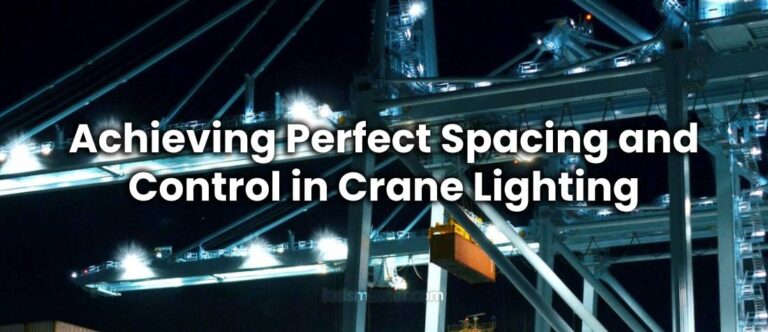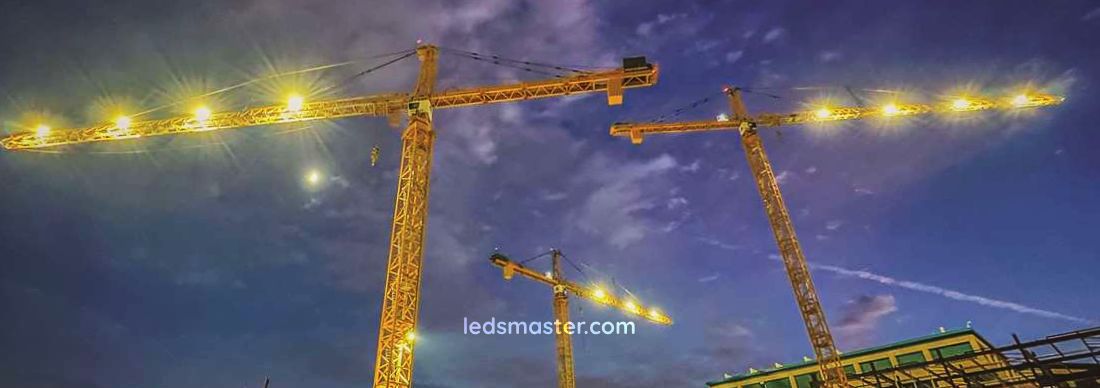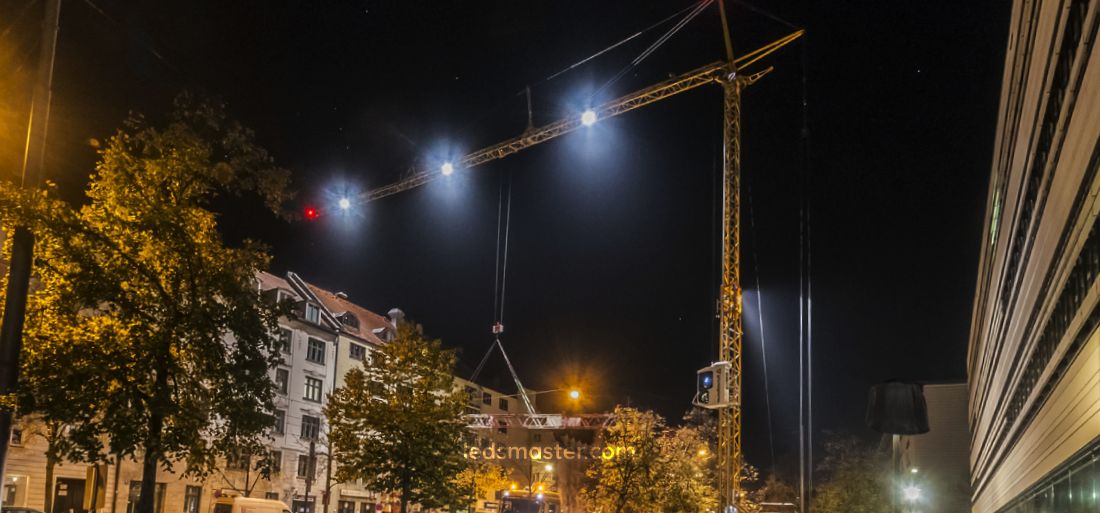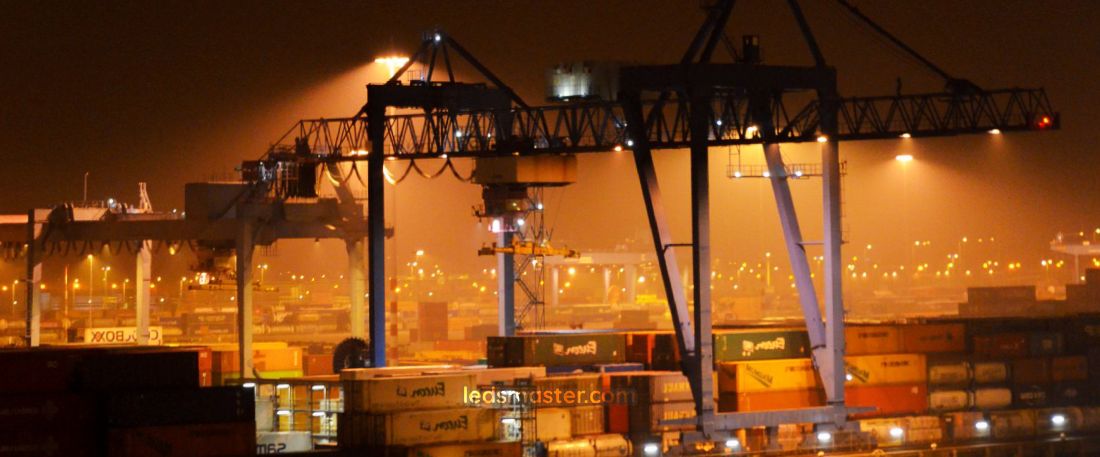
Good lighting can make all the difference in crane operations. It ensures clear visibility, enhances safety, and keeps things running smoothly. Whether you’re working in a busy construction site, an industrial warehouse, or a hazardous environment, proper lighting ensures that the crane operator has clear visibility, reducing the risk of accidents and improving the overall workflow.
Get your complimentary lighting design today
Proper lighting helps minimize risks, enhances visibility, and supports effective operational control. The installation process involves several stages, from assessing environmental needs and selecting appropriate lighting fixtures to the installation, maintenance, and continuous monitoring of lighting systems.
Table of Contents
ToggleBefore installing lighting on a crane, a comprehensive evaluation of the working environment and the crane’s operational needs is required. The lighting solution must be tailored to the specific challenges of the site, whether it is an indoor factory, an outdoor construction site, or a hazardous environment.
Environmental conditions play a significant role in the type of lighting used for crane operations. Outdoor cranes are subject to weather conditions such as rain, snow, high winds, and extreme temperatures. In these cases, lighting fixtures must be designed to resist moisture, corrosion, and harsh environmental factors. Sealed and waterproof lighting solutions, such as floodlights or LED lights with protective casings, are often preferred for outdoor installations.
For cranes in indoor environments, the lighting system must take into account the layout of the space, ceiling height, and potential obstacles that could affect light distribution. In industrial settings, harsh chemicals or high humidity can affect the durability of lighting systems, so choosing appropriate fixtures that can withstand such conditions is necessary. Indoor lighting may include ceiling-mounted fixtures or task-specific lights placed around the crane’s operational area.
The type and size of the crane also influence the choice of lighting. Different cranes, such as overhead cranes, gantry cranes, or mobile cranes, each have distinct features and operational requirements. For example, an overhead crane with fixed rails may require different lighting compared to a mobile crane that moves across a large construction site.
In larger cranes, such as those used in shipping yards or heavy lifting, additional lighting may be required to cover the extensive work areas that the crane operates within. The layout of the crane and its reach will also determine how many lighting fixtures are needed and where they should be placed for maximum coverage.
Lighting must be carefully selected based on the intensity and distribution needed for the job. For precise operations, such as lifting delicate materials or performing detailed inspections, task-specific lighting will be required to focus on specific areas. Meanwhile, general lighting provides illumination across a broader area to support the crane’s operations.
The lighting system should also meet regulatory standards and safety guidelines. These standards can vary based on the region and type of operation. Adherence to these requirements ensures that the crane lighting installation is safe, functional, and compliant with relevant codes.

Energy efficiency is a consideration when selecting lighting solutions for cranes. Given that cranes are often in operation for extended periods, selecting energy-efficient lights can reduce operational costs and minimize the environmental impact. LED lighting has become the preferred choice for many crane lighting installations due to its long lifespan, low power consumption, and minimal heat generation.
In some cases, sensors can be incorporated into the lighting system to automatically adjust the intensity of the lights based on ambient light levels or the crane’s operational status. This ensures that energy is only used when necessary, further reducing consumption.
Once the type of lighting has been chosen based on the factors mentioned above, the next step is the installation process. Installing crane lighting involves several stages: planning, selection of fixtures, wiring, mounting, and testing.
A thorough planning phase is essential before beginning installation. The first step involves assessing the crane’s operational area to determine where lighting will be needed. Factors such as crane reach, operator visibility, and potential hazards should all be considered. This evaluation helps identify the ideal placement for lights, ensuring that all areas requiring illumination are covered.
During the planning stage, the electrical requirements of the crane should be taken into account. This includes determining the type of power source available, how the lighting system will be wired, and ensuring that the electrical system can handle the load without overloading circuits.
Selecting the right lighting fixtures for the crane is a pivotal aspect of the installation process. The fixtures should be durable and capable of providing the necessary level of illumination for the work environment. Commonly, LED lights are chosen for their energy efficiency, long lifespan, and ability to provide bright, clear light. In high-risk environments, explosion-proof lighting may be necessary to prevent sparks that could ignite flammable gases or dust.
Lights should be installed in positions that maximize their effectiveness. For example, task lighting may be mounted directly onto the crane to direct light to specific areas, while general lighting may be mounted around the perimeter of the crane’s operational area.

The electrical system is one of the most critical aspects of crane lighting installation. The wiring must be installed in a way that ensures it is protected from damage during crane operation. Additionally, the power supply must be reliable, ensuring that the lights remain operational even in adverse conditions.
It is important to ensure that the electrical connections are made securely and that the lighting system is connected to the appropriate power source. In some cases, cranes may have their own dedicated power supply for lighting, especially in larger cranes or facilities where constant operation is required.
The mounting of the lights must be done with care to ensure that the lights are stable and properly aligned. Improper mounting can lead to issues such as light misdirection, insufficient illumination, or the risk of the lights becoming dislodged during crane operation. Depending on the crane’s design and the type of lights used, mounting may involve installing brackets, suspension systems, or direct attachment to the crane’s frame.
Special attention should be paid to the height and angle at which the lights are installed. Proper positioning ensures that the lights are effective in covering the intended areas, such as the crane’s path of travel, the load-handling area, or the operator’s station.
Once the lights are mounted and the electrical connections are completed, the lighting system should be tested to ensure it works as intended. This includes checking the light output, ensuring all lights are functional, and adjusting the angles of the fixtures if necessary. Any dead spots or areas that are not well-lit should be addressed, either by repositioning the lights or adding additional fixtures to fill in the gaps.
Testing is also the stage at which any adjustments to the light intensity or focus can be made. For example, task lighting may need to be adjusted to focus more directly on the operator’s work area, while general lighting may need to be adjusted to provide consistent illumination across the entire operational zone.
Ongoing maintenance and periodic inspections are essential to keep crane lighting in optimal condition. Over time, lighting fixtures can experience wear and tear due to exposure to environmental factors, mechanical stresses, or electrical issues. Regular inspections and maintenance help ensure that the lighting system continues to operate effectively, providing consistent illumination and supporting safety.
A regular inspection schedule should be established to assess the condition of the lighting system. This includes checking for any damage to the fixtures, electrical connections, or wiring. It is also important to inspect the lights for signs of wear, such as dimming, flickering, or complete failure. During inspections, any malfunctioning lights should be replaced promptly to maintain full functionality.
Dirt, dust, and other debris can accumulate on lighting fixtures over time, diminishing their effectiveness. Cleaning the lights regularly helps maintain their brightness and ensures that they continue to provide optimal illumination. In harsh environments, cleaning may need to be more frequent, as cranes can accumulate dust, chemicals, or corrosive materials that can affect the lights’ performance.
It is also necessary to replace lights that have reached the end of their lifespan or those that no longer function correctly. Replacing lights promptly helps avoid interruptions in crane operations and ensures that the crane remains compliant with safety standards.
Electrical issues, such as faulty wiring or connections, can cause the lighting system to malfunction or fail entirely. Routine checks of the electrical components are essential to prevent issues that could affect the lighting system’s performance. This includes checking circuit breakers, fuses, and connections to ensure they are secure and free from damage.

Safety is a top priority when installing crane lighting. Ensuring the correct setup not only improves visibility but also prevents accidents and ensures compliance with regulations. Here are a few key areas to focus on when considering safety during crane lighting installation.
When installing crane lighting, ensuring that the electrical system is properly wired and grounded is critical to avoid electrical hazards. Loose connections or improperly insulated wiring can lead to shocks, fires, or even equipment damage. Regular inspections and using certified electrical components are key steps to keeping the system safe.
Improperly positioned lights can create glare or shadows that obstruct the crane operator’s view, leading to potential accidents. It’s essential to carefully position the lights to provide clear, consistent illumination without causing discomfort or visibility issues for the operator or nearby workers.
Crane lighting installations must comply with industry standards and regulations, such as those set by OSHA or local safety authorities. These regulations often cover aspects such as light intensity, installation methods, and the types of lighting that should be used in different environments. Adhering to these standards ensures a safer work environment for everyone.
Crane lighting installation is a process that requires careful consideration of several factors, including environmental conditions, crane specifications, lighting requirements, and energy efficiency. By selecting the right lighting fixtures, properly mounting them, and ensuring regular maintenance, businesses can create a safer and more efficient environment for crane operations. Proper lighting not only enhances visibility but also supports overall operational success by minimizing the risks of accidents and improving precision in high-stakes tasks.